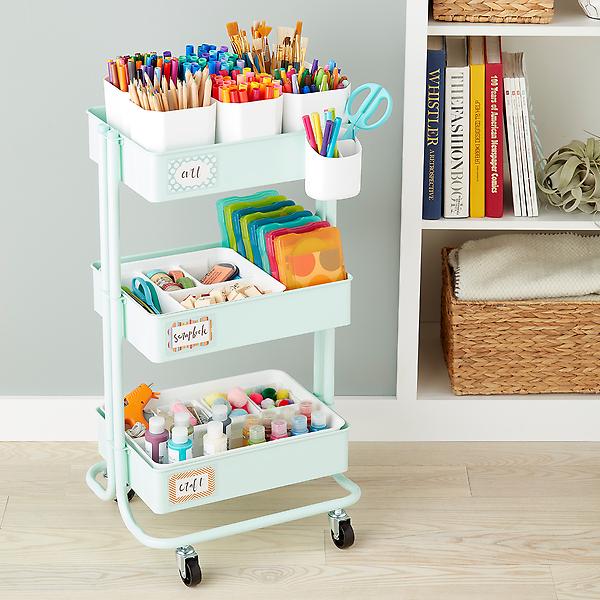The primary concern for most of my students when it comes to making art is time. They often find themselves lacking the time needed for artistic pursuits, often getting sidetracked by activities such as playing games on their phones or scrolling the “gram.”
Making time for art is a worthwhile effort. There are countless studies that show the health benefits of art-making, from relaxing the nervous system, calming the mind, and the gift of feeling inspired. Even when art-making is hard, we benefit from engaging in a right-brained activity that lets our rational mind tame a break.
Allocating time for art must be a conscious decision, and there are various small actions we can take to carve out that essential creative time. In this article, I will present multiple strategies to help you make time for your creative spirit.
Strategies for Carving Out More Art Time
1. Set Priorities
Start by figuring out what’s most important to you and see how making art fits into those priorities. This can help you use your time better. Consider the activities that truly matter and bring you joy, then assess how incorporating art aligns with those values.
By understanding the connection between your artistic pursuits and your core priorities, you can make more informed decisions about how to plan your time effectively. This thoughtful approach ensures that making art becomes an integral part of your life, enhancing your overall well-being and satisfaction.
2. Schedule Time Each Week
Considering the hectic nature of most lives, finding time for art can indeed feel like a luxury. A practical starting point is to schedule just 20 minutes a week for your artistic endeavors. Whether you’re a morning person or someone who comes alive at night, tailor your art time to your peak hours.
Allocating a mere 20 minutes can be easily achievable for most. Just pinpoint a suitable day and time, note it in your calendar, set a phone alarm, and jot it down on a sticky note for a visual reminder.

3. Reallocate Your Time
Alternatively, consider reallocating time from activities that consume a significant portion of your time. Designating a “no social media day” to redirect that time toward art-making can be a game-changer. If TV-watching is a common pastime, explore the possibility of reallocating that time to engage in artistic pursuits.
Another suggestion is to incorporate art into your work breaks, perhaps through quick sketching sessions. Much like any other habit-forming endeavor in life, integrating art into your routine will require intentional scheduling, especially if it’s not already a regular part of your routine.
4. Create Easy to Access to Your Supplies
To increase the chances you will make art during your appointed time, designate a specific area of your home for art activities. Having a dedicated space facilitates a seamless transition into a creative mindset and also eliminates the uncertainty of where to set up and locate your materials. Ideally, keep your supplies readily available.
If you don’t have the room for a dedicated art space, consider using a large plastic tub to store all your materials. When it’s time to work, simply take out the tub and set it up on your desk, kitchen table, or even the floor.
Alternatively, invest in an art cart; these are both affordable and efficient, providing organized storage for most of your supplies. Regardless of your storage solution, the key is to ensure that your materials are easily accessible and ready for use.

If you’re seeking more ideas on creating an art-making space, including tips on protecting your kitchen table or carving out a nook in your room, explore the insights in this article entitled “How to Create Art Studio Space.”
5. Involve Others
Engage others in your art-making goals as an extra strategy. This not only builds a support network for you but might also spark their interest in exploring new hobbies. You could request someone to check in with you regularly, asking, “Have you made art today?” This establishes an informal accountability system, utilizing your loved ones for additional support.
If you have kids, consider turning art-making into a family activity. Depending on their age, provide crayons, markers, watercolors, and paper for the kids while you work on your art. While it may seem distracting, I’ve observed that kids often get engrossed in their own creative zones, so it’s worth a shot!
6. Learn to Say No
Making more time for art can be as simple as saying no to other things. This requires thinking about your priorities and using strategies to protect the precious time you dedicate to art. By evaluating how important each commitment is, you can make informed decisions and choose to protect the space needed for your creative pursuits.
When you empower yourself to create boundaries around art-making, you reclaim the autonomy to prioritize your creative endeavors, fostering an environment where your artistic spirit can thrive without being compromised by external demands.
7. Join a Creative Community
Joining a creative community is like discovering a treasure trove of inspiration and camaraderie. When you connect with fellow artists, you gain a sense of belonging and shared passion. Whether you participate in local art meet-ups, engage in online forums, or join dynamic social media groups, these communities become platforms for collaboration, feedback, and the exchange of ideas.
Personally, I’ve discovered immense inspiration and support within such creative circles. The varied perspectives and collective wisdom of fellow artists haven’t just enriched my artistic journey, but have also served as a source of encouragement during both triumphs and challenges.
Students get membership in my art community through their purchase of Abstraction Beyond Boundaries, which helps beginners and intermediates learn how to paint abstractly through a deep dive in color, composition and techniques.
8. Use Inspirational Quotes and Mantras
If you really want to make art but struggle to find the time, consider putting a note with an encouraging saying or quote on your bathroom mirror. Choose something like “You are Worth Creative Time” or “Create something today that your future self will thank you for.” Select a phrase that relates to the main issue you face in making art.
If social media always distracts you, try a mantra like “I release the grip of scrolling, embracing the canvas of creation. My art matters more than the digital noise, and each moment spent creating is a step toward my truest self.” These notes can serve as a great reminder of your artistic goals, helping you stay on track.
Conclusion
Remember, finding time for art is not just about scheduling; it’s also about creating a supportive environment and developing habits that foster creativity. By incorporating small changes into your routine, like setting aside a specific space for your art supplies or involving others in your creative journey, you actively pave the way for more artistic expression in your life.
These adjustments, coupled with empowering mantras and reminders, create a positive atmosphere that encourages your artistic spirit to flourish. As you embark on this journey, keep in mind that every moment dedicated to your art is a step towards self-discovery and personal fulfillment. So, embrace the process, celebrate your creative wins, and enjoy the transformative power of art in your daily life.
ABOUT ANDREA CERMANSKI
I am an artist out of Santa Fe, New Mexico who has been painting for almost 30 years. I love to teach first-timers as well as experienced painters who need a creative reboot. My work has been displayed in several galleries around the country, and I have a Bachelor’s in Art History, a Master’s in Art Education, and had my work in a show juried by Judy Chicago. The idea of getting more people painting makes me light up as I want to inspire more people to express their creative selves and tap into a place of joy and calm.
WANT TO LEARN MORE?
- Subscribe and get one of the FREEBIES below!
- PDF explaining How to Use My 5 Favorite Mediums
- Ebook on How to Move From Representational Painting to Abstraction: 5 Transformative Art Lessons
- Take the Quiz: What Abstract Artist are you Destined to Be?
- Check out My Online Abstract Painting Course
- Read More Painting Tips Blog Posts
- Check out My Paintings & Art Prints for Sale
- Follow Me On YouTube, Instagram, or Pinterest